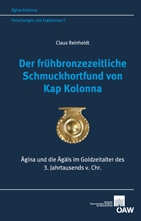
Der frühbronzezeitliche Schmuckhortfund von Kap Kolonna, pp. 99-104, 2008/06/05
Ägina und die Ägäis im Goldzeitalter des 3. Jahrtausends v. Chr.
Der in der prähistorischen Siedlung von Kap Kolonna/ Ägina unter dem Fußboden einer Hauseinheit der ausgehenden Frühbronzezeit aufgefundene Schmuckhortfund stellt in mehrfacher Hinsicht eine bislang in der zentralen Ägäis ungewöhnliche Verwahrung dar. Der aus Edelmetall (Gold, Silber) und nichtmetallischen kostbaren Werkmaterialien (Karneol, Bergkistall, Fritte) bestehende Schmuckkomplex repräsentiert trotz partieller intentioneller Deformation der größeren Bestandteile (Nadeln) eine sekundäre Kollektion gebrauchsfähiger Schmuckstücke, die in Bezug auf ihre originale funktionelle Verwendung allerdings ausgesprochene Restposten darstellen. Neben einer in mesopotamsicher Ätztechnik dekorierten Karneolperle sind auch andere Bestandteile des Hortes hinsichtlich ihrer typologischen Klassifizierung als Produkte anatolischer resp. mesopotamischer Feintoreutik anzusprechen. Der Fund wirft ein neues Licht auf die Beziehungen zwischen der zentralen Ägäis und den östlichen Hochkulturen Anatoliens und Mesopotamiens, die sich bislang aufgrund des geringen Bestandes orientalischer „Exotika“ in der Ägäis nur in Ansätzen erschlossen haben. Eine übergreifende Untersuchung dieser fremden Prestigegüter in der Ägäis des 3. Jahrtausends v. Chr., zu denen der Hortfund von Kap Kolonna nun als bedeutender zusätzlicher Komplex hinzutritt, zeigt aber, daß die Kontakte seitens des Orients während des Frühdynastikums in die zentrale Ägäis hinein nicht im Rahmen von direkten und geregelten Handelsbeziehungen erfolgten, sondern daß das Auftreten dieser exotischen Prestigegüter in der Ägäis im Rahmen einer gestaffelten Etappenbewegung zu werten ist, im Zuge derer sukzessive große Distanzen überwunden werden konnten und die aus einem komplexen System zwischengeschalteter kleinräumiger Austausch-Netzwerke bestanden hat.
…
The jewellery hoard excavated under the floor of an Early Bronze Age house-unit in the prehistoric settlement of Cape Kolonna/Aigina represents in many ways an exceptional collection still unique in the central Aegean of the late third millenium B.C. The material consists of precious metals (gold, silver) and several nonmetallic valuable objects (carnalian, rock-crystal, frit) and belongs to a secondary hoard of pins, pendants and beads, partly bent for the deposit context (pins). Concerning their original typological function some of the objects represent particular remaining stocks. Apart from a small carnalian bead decorated in the typical Mesopotamian etching-technique, other items of the deposit represent products of Anatolian and Mesopotamian jewellery crafts. The hoard casts new light on the relationship between the central Aegean and the Eastern advanced civilisations of Anatolia and Mesopotamia, a relationship that has as yet only been illustrated with respect to a few oriental "exotica" in the Aegean. A general investigation of all these foreign precious objects in the Aegean during the third millennium where the hoard from Cape Colonna can be added as an important new complex shows that the contacts on the part of the Eastern civilisations during the Early Dynastic Period do not form real trade activities controlled by direct and regular economical conditions. The appearance of foreign precious objects in the Aegean is the result of staggered stages in early and more accidental commercial contacts which can nevertheless bridge long geographical distances and spaces and which consist of a complex system of interlocked and small-spaced networks and merchant units.